This is an archive of information released in the past.
Disclaimer: It may contain broken links or outdated information. Some parts may not function in current web browsers.
*Visit https://humans-in-space.jaxa.jp/en/ for the latest information.

TOPICS
JAXA and NASA joint workshop on ISS utilization!
Following fiscal last year, JAXA and NASA held a joint workshop on International Space Station (ISS) utilization on July 23. Under the Japan-US Open Platform Partnership Program (JP-US OP3*), this workshop has been held since 2016 to lead to the creation of new results as well as to help generate and maximize the benefits of utilizing Japanese Experiment Module "Kibo" and the ISS as a whole. The workshop presents excellent ISS utilization results brought by JAXA- NASA cooperation and collaborative ideas and plans which help to further maximize the results.
*JP-US-OP3 was concluded in December 2015 by Japan and US governments as a new collaborative framework for the extended ISS operations through 2024
- TOPICS/Last year's article
- JAXA and NASA hold their second workshop on ISS utilization!(September 26, 2017)
JAXA/NASA joint workshop overview
| Date | July 23 (Mon), 2018 |
|---|---|
| Venue | San Francisco, California, USA |
| Overview | The workshop was successful with about 150 participants centered on potential users, even some of whom had no seats. JAXA, NASA and researchers from both countries presented the results of Japan-US collaboration and future plan and prospects based on OP3, drawing participants' interest in more detailed collaboration. |
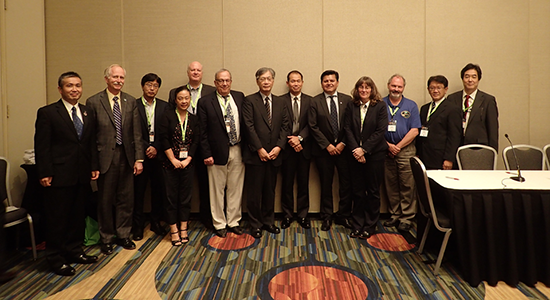
Panelists at JAXA/NASA joint workshop
 |
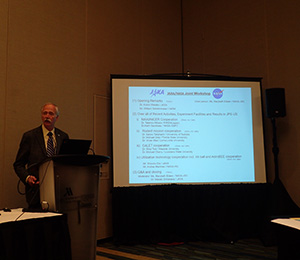 |
|
Opening speech |
Opening speech |
 |
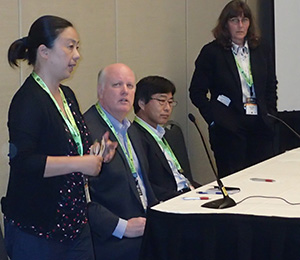 |
|
Joint WS General discussion (Shirakawa, JAXA Planning Group Leader and Mary Beth, NASA ISS Research Integration Office manager) |
Japanese Researcher answering a question about mice experiment (Prof. Takahashi (2nd from right)) |
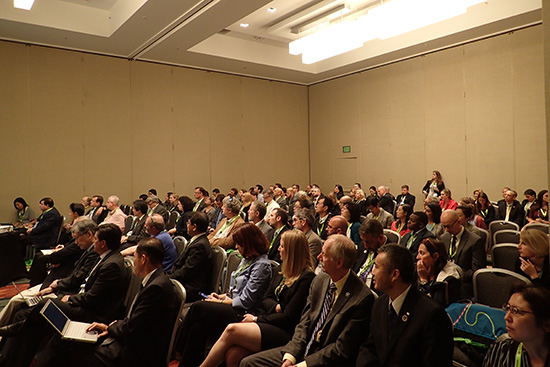
Participants at site
Overview
- Opening speech
Dr. Wakata, Director General (Manager of Human Spaceflight Technology Directorate), JAXA and Mr. Gerstenmaier, Associate Administrator of Human Exploration and Operations Directorate, NASA, celebrated this milestone year which marks the 20th anniversary since the ISS assembly started and the 10th anniversary since "Kibo" utilization started, and expressed their expectation for further development in Japan-US cooperation through JP-US OP3, a collaborative framework which helps researchers in Japan and US join their hands.
In addition, Mr. Gerstenmaier introduced to participants successful examples of the JP-US OP3: high-precision and prompt observation of celestial phenomena realized by the MAXI-NICER* collaboration (which will be described later) and contribution to new drug development through high-quality protein crystal growth experiments conducted on board "Kibo".
* MAXI:Monitor of All-sky X-ray Image
NICER:Neutron star Interior Composition Explorer
- Presentation of research results obtained through JP-US OP3
MAXI/NICER Cooperation
Introduced were the results obtained by unveiling celestial phenomena which happen in a short interval (from a day to several days), such as gamma-ray bursts, by MAXI (a unit monitoring X-rays in a celestial body with a widened field of view) which discovers them through a network on the ground and reports to NICER (a unit observing X-rays which occurring from a celestial body in details with high resolution) team and NICER which observes the concerned celestial body in detail.
Additionally introduced the OHMAN* project to realize detailed observation with NICER in a shorter time (from a few minutes to a few hours) after the discovery by MAXI by directly collaborating the two units on board ISS.
* OHMAN:On-orbit Hookup of MAXI And Nicer
 |
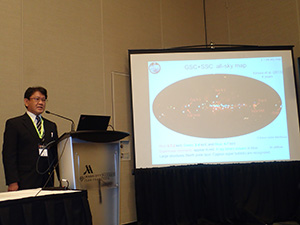 |
|
Dr. Keith Gendreau(NASA GSFC) |
Dr. Mihara, Senior Researcher (RIKEN) |
Rodent Mission Cooperation
The overview of an experiment with the animal breeding unit that enables world's first breeding of on-orbit 1G-control animal group was reported along with its resulting situation in which genes with their expression altered due to the impact of weightlessness are being strictly identified and undergoing function analysis. A US researcher who shared samples also presented the research result on the impact of weightlessness on eyes (eyesight and vision) which happened to part of the astronaut.
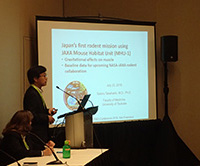 |
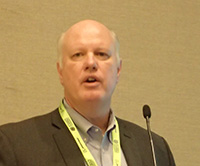 |
 |
|
Prof. Takahashi |
Dr. Michael Delp |
Dr. Vivian Mao |
CALET Cooperation
As the past observation results with CALET which was launched in 2015, Japan and US researchers presented electron spectrum in high-energy region up to 4.8TeV and analysis results including those of simultaneous gamma-ray observation. The analysis work in cooperation with international research teams has achieved a variety of scientific results contributing to space physics.
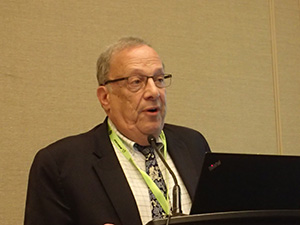 |
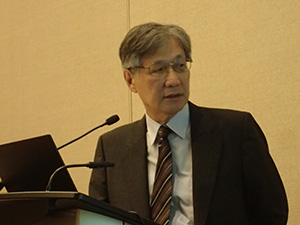 |
|
Dr. Michael Cherry (Louisiana State University) |
Prof. Torii (Waseda University) |
Utilization technology cooperation including Int-Ball and Astrobee cooperation
The overview of the on-orbit demonstration of robotics technology on board "Kibo" and future prospect was delivered. As part of the JP-US OP3 activities, proposal of educational events related to cooperation in Asia which will be held on orbit by JAXA using Int-Ball and by NASA using Astrobee were also introduced.
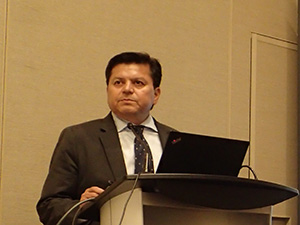 |
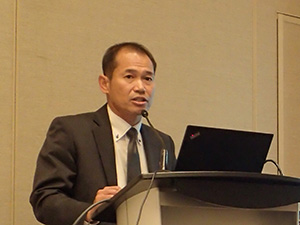 |
|
Mr. Andres Martinez (NASA-HQ) |
Mr. Doi, Senior Researcher (JAXA) |
| Copyright 2007 Japan Aerospace Exploration Agency | Site Policy |